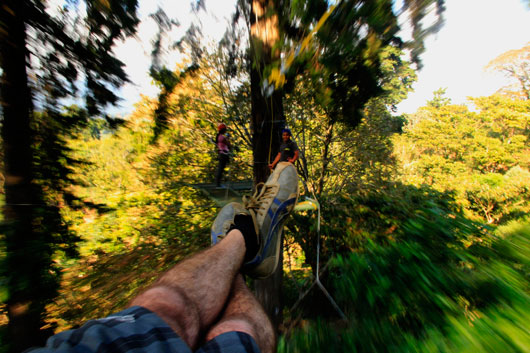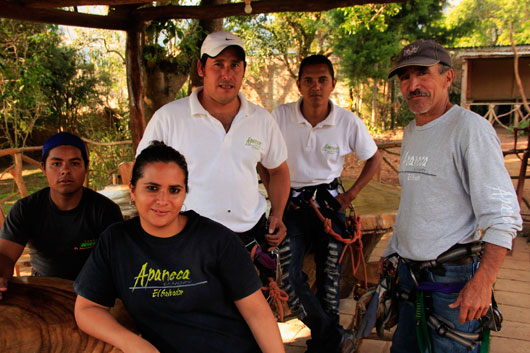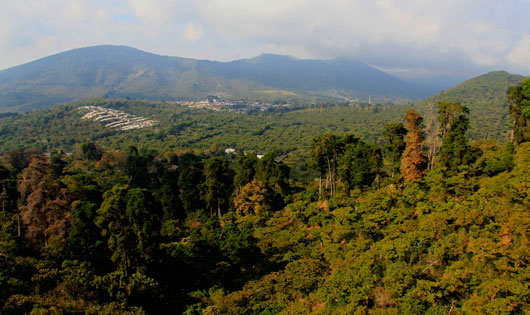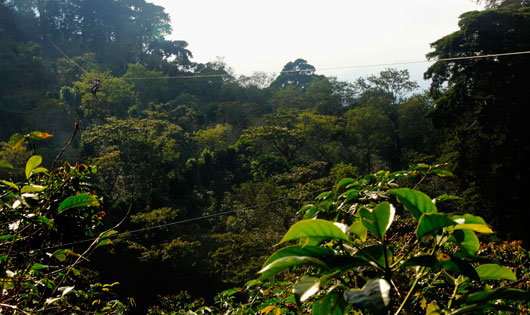
Have you ever encountered something while traveling, and thought “I should bring this home”? Was it a type of food? A style of dancing? For Wilson Garcia Nunez from Apaneca, it was zip-lining. The difference between him and the rest of us, is that he actually did it.
His boyish face must have been grinning when he returned from a vacation in Costa Rica, bringing home not just an idea, but the team who had set up the zip-line course he’d fallen in love with in Monteverde. But don’t let that boyishness fool you, beyond the guts to follow through with a dream, he also showed the business savvy to make his vision a reality, perfectly placed along the Ruta de las Flores, with all its looming tourism potential.
Now, eight years later, he handed me a yellow helmet and gloves while his uncle checked my harness. “We’ve had people from all over the world” he tells me, quiet pride in his voice. “England, France, Canada. Probably a dozen nationalities.” The feeling extends throughout the family business, and Uncle chipped in. “This morning we had a whole group, eight people, from Ireland. And yesterday was a couple, man and woman, from Sweden.”

This surprised me a little, since outside of Playa Tunco I had met only one other obvious foreigner in El Salvador, but perhaps that’s because they had done their research and come straight here to La Ruta de las Flores. The billboard on the highway and banners in the office clearly showed gringos enjoying themselves, and I could imagine the excited conversations that have taken place on this platform as people got ready for the first of thirteen cables.
“Do you only get tourists, or do locals come up here too?” I was curious.
“A lot of the people in town have done it, especially when we opened. We do get people from the capital and other parts of El Salvador, but foreigners are more into it.”
The first five lines are short and not very steep, to give newbies a chance to practice braking and getting comfortable on a zip line before the metal shuttle and clipped carabiner slide them out over the treetops with an unstoppable whir. After the easy five, there’s a rest point where they hand you a bottle of water, and perhaps give you one more chance to back out.
I love zip-lining, the anchors were solid and clean, not a speck of rust, and the terrain was beautiful before I’d even clipped in. I chugged that bottle of water in ten seconds and off we went.
There’s something about emerging from the shade of a stout pine tree to the full Salvadoran sun, looking down the valley below to the white walls of Apaneca, and further afield, the cluster of roofs and color that marks Ataco. All to the soundtrack of steel that reminds you that you’re flying.
“This next one has the best view,” Wilson told me as we clipped in to the sixth cable. “If you like, you can stop in the middle and take pictures.” So that’s what I did. But when the pictures were taken, I couldn’t help but linger a bit longer, drifting in the Salvadoran sky, enveloped in warmth, a soft wind and an awareness of my stillness, more valuable in this place of fluidity and motion. I leaned back and closed my eyes, just for a moment released from the grip of gravity.

Each line takes you lower, crossing two and a half kilometers of distance until eventually you are whizzing to a stop among the coffee plants, their ripe red berries blushing to see you, and the scent of soil makes you wonder “Do I detect a hint of cappuccino?”
“How was it?” Wilson asked when he dropped to the platform behind me. My grin gave him the answer while I was still looking for the right Spanish word for “Fantastic.”
“Come back tomorrow, we also have bicycle or buggy tours to the lagoons.” Laguna Verde and Laguna de las Ninfas are a pair of nearby volcanic crater lakes. It was with real regret that I told him I had to leave town the next morning.
“Next time,” we agreed.
I mean it when I talk about “next time” in El Salvador. The country, the Ruta de las Flores, Apaneca, and even this particular company are all worth returning to, for their beauty, character, and myriad experiences, but there’s something else, too.
On previous vagabond wanderings through Central America I watched my dorm room payments and tourist tickets going to overseas owners: Germans, Dutch, Americans and Australians. But here, my $35 was going to this family, who was doing this work, on their land, in their town. My tourist dollars, given in gratitude for the experience of this place, would be staying here. The same was true of my accommodation in Ataco, where Julio Cesar ran Hostal Cipres in his hometown, with the care and pride of a man working at home.
I liked that.

After a week of solid election politicking, the chance to escape the banners and flags (that wallpapered the streets of Apaneca just as much as the capital) had been a welcome change. The political future of the nation might be in doubt, but there is no uncertainty that one can have a good time in El Salvador. I ate well, saw beautiful things, and basked in February heat. I touched the nation’s past, present, and future. I met people, felt welcome, and learned from them.
“Apaneca means ‘River of the wind’” Wilson told me. “Up at the top of the mountain, there are bare trees, all the leaves blown off by the wind. I want people to be able to come here and do this, to feel like they are part of that river.”
He has succeeded.
Read Ethical Traveler's Reprint Policy.
